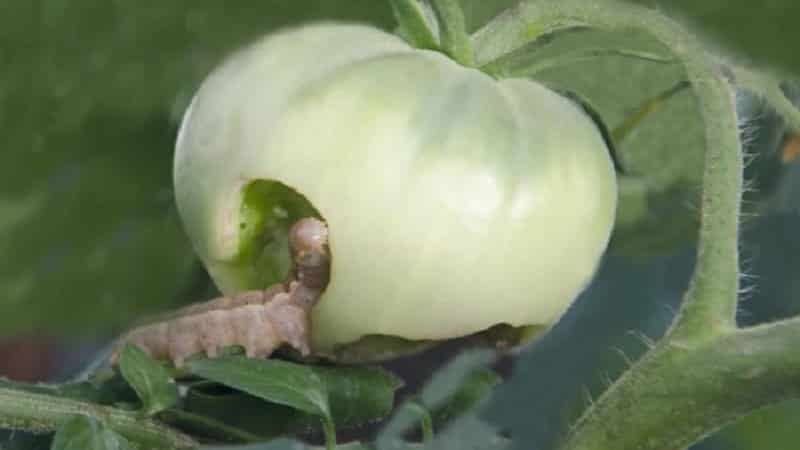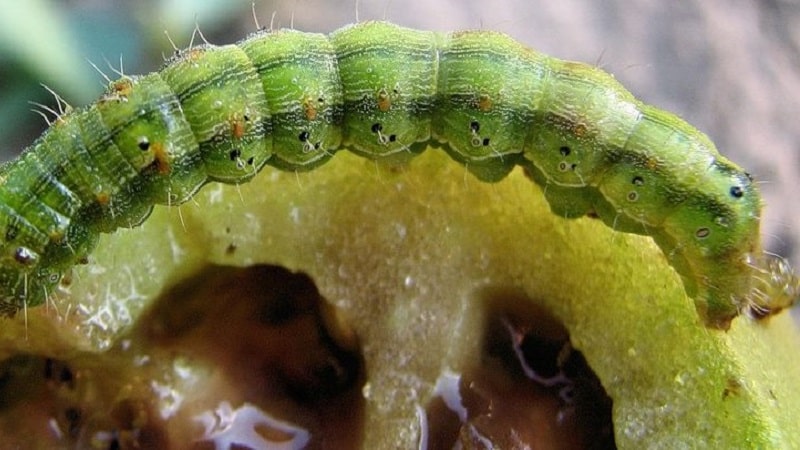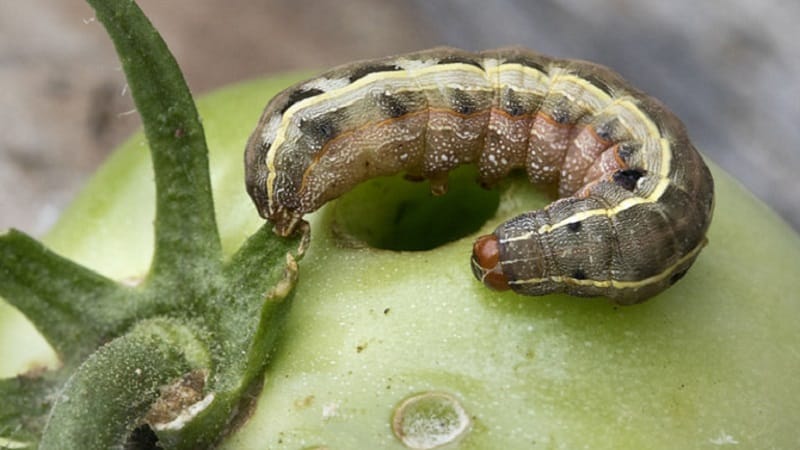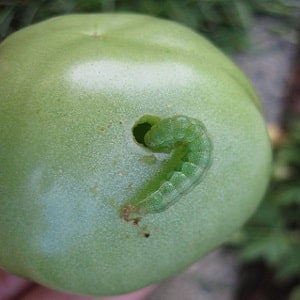How to deal with caterpillars on tomatoes in a greenhouse
The death of tomatoes from caterpillars is a problem familiar to many gardeners. Most often, plantings are affected by the tomato cutworm, whose peak activity occurs in mid-summer. In just 20 days of being in the caterpillar stage, this pest can leave a farmer without a harvest.
Preventive measures will help prevent the appearance of cutworms in the garden beds. If it is not possible to protect the plantings from damage, they use “heavy artillery” - contact-intestinal insecticides. Along with them, folk remedies and entomophages (microscopic insects) are used. They destroy the pest no less effectively and allow you to collect an environmentally friendly product.
How to treat tomatoes against caterpillars in a greenhouse? What drugs are the most effective? You will receive detailed answers to these and other questions in the article.
Caterpillars on tomatoes and external manifestations of infection
The appearance of an unsightly butterfly on tomato bushes in early summer, similar to a large moth, should immediately alert you. During this period, they are not dangerous, feed only on nectar and lay eggs. It is the caterpillar that causes damage to the plant.
Noctuid fecundity – high. During the season, an adult lays from 500 to 1000 eggs. In warm weather, eggs mature in 5 days, in cool weather - in 10.

The caterpillar development period is 20 days.. All this time she gnaws the stems, leaves and fruits of tomatoes. Then the caterpillar goes into the ground, turns into a pupa and overwinters in the ground until the next season.
The caradrina or tomato cutworm at the butterfly stage has a wingspan of up to 3.5 cm. The front pair of wings is gray-brown in color, the back pair is pink-tinged. Ornament with strokes, zigzags and stripes.
Appearance of caterpillars:
- large body – 25-30 cm in length;
- color - from green to brown;
- on the back there are thin longitudinal stripes with edges;
- on the sides there are dark wide stripes, and under them there are thinner, yellow stripes;
- the abdomen is light with white spots.
Pest activity begins at night: caterpillars gnaw holes in greenery and fruits, and in the morning they hide underground to a depth of 5 cm.
It can be useful:
Why do yellow spots appear on tomato leaves?
The reason for the appearance of purple spots on tomato leaves
Reasons for appearance
The main reasons for the appearance of cutworms on tomatoes:
- insufficient tillage after harvest;
- non-compliance with the principle of crop rotation;
- non-compliance with the rules of agricultural technology (loosening, weeding);
- the use of ineffective means to control pests during the period of their activity (the remaining caterpillars go underground for the winter).
Basic methods of struggle
Used to control tomato cutworm:
- manual collection of caterpillars;
- spraying with chemicals;
- treatment with folk remedies;
- biological method.

Chemicals
How to deal with green caterpillars on tomatoes in a greenhouse? Chemical treatment is the most effective method pest control. Spraying is carried out taking into account the fact that pesticides are removed from the fruit within 20-30 days. Therefore, before using chemicals, calculate the expected start date of harvest.
Attention! Gloves are used to protect the skin, and respirators are used to protect the respiratory system.
List of effective means:
- "Inta-Vir" – contact-intestinal insecticide. The substance cypermethrin destroys butterflies and caterpillars. The protective effect lasts up to 15 days. Dissolve 1 tablet in 10 liters of water and use it during the tomato growing season.
- "Decis Profi" – fast-acting contact-intestinal insecticide. Belongs to the class of pesticides moderately hazardous to humans. Contains the substance deltamethrin. To treat 100 m², 0.5 g of the substance is dissolved in 5 liters of water. The product is used before flowering. The protection period is 10-15 days.
- "Avant" – an insecticide of moderate hazard class for humans. Contains the substance indoxacarb. Resistant to rain, effectively destroys eggs and caterpillars. The consumption rate per 1 ha is 200-300 ml. The product is used no more than twice during the growing season.
- "Arrivo" – contact-intestinal insecticide. Shows high effectiveness against cutworm caterpillars at low application rates. Consumption per 1 ha – 240-320 ml. Treatment is one-time, during the growing season.
- "Aktara" – systemic insecticide of contact-intestinal action. The active ingredient is thiamethoxam. Destroys the caterpillar at the feeding stage. 4 g of powder for irrigation or 1.2 g for spraying are dissolved in 10 liters of water.
- "Tanrek" – systemic insecticide of contact-intestinal action. The active ingredient is imidacloprid. The protection period is 30 days. The drug can be combined with Fitosporin. The product is used for spraying (5 ml per 10 liters of water).
- "Fitoverm" – enteric-contact insectoacaricide. Irrigation is carried out twice during the entire growing season. 1 ml of the drug is dissolved in 10 liters of water. The protection period in the greenhouse is up to 20 days, in the garden – up to 15 days.
Important! It is recommended to alternate chemicals used to kill cutworm caterpillars from season to season.The pest is highly resistant to such agents. What worked this year will not work next year.
Folk remedies
Folk remedies are effective in detecting the first pests. Unfortunately, in case of mass destruction, they do not bring results.
Recipes for folk remedies:
- Pour a bunch of chopped garlic arrows or a head of garlic into 1 liter of hot water and leave for 3-4 days. Bring the product to a volume of 10 liters and use it to treat bushes twice a month.
- Pour 300 g of tobacco dust into 10 liters of boiling water and leave for 24 hours. Apply to spray tomatoes every two weeks.
- Fill a galvanized barrel with chopped bird cherry herbs and fill it to the top with boiling water. Leave for a day, use for spraying bushes and watering the soil.
- Pour a kilogram of fresh wormwood into 3 liters of water and boil for half an hour, then increase the volume to 10 liters and irrigate the bushes twice with an interval of two weeks.
- Fill a 10-liter bucket with burdock, chamomile, datura, yarrow, celandine, potato tops (optional) and fill with water. Leave for four days and use to irrigate bushes once every two weeks.
Mix shavings of laundry or tar soap into each solution. For a 10 liter bucket – 30-50 g.

Saline solution is effective against cutworms. Dissolve 2 tbsp in 10 liters of water. l. rock salt and water the bushes generously.
Read also:
Saving the tomato harvest - tomato pests
Biological methods of control
What to do if caterpillars eat tomatoes in a greenhouse? Their natural enemies are used to fight them.. Microscopic Trichogramma insects lay eggs inside cutworm eggs.Damaged cocoons turn black after 2-3 days. The method is used twice a season.
Caterpillar parasite bracon provides significant assistance in the fight against armyworms. The female insect pierces the caterpillar's skin and injects a toxin that destroys the digestive system.
Important! The use of entomophages is a guarantee of environmentally friendly products. The biological method is used when growing tomatoes on an industrial scale.
How to prevent infection
Prevention measures:
 the soil is dug up in the fall using the fall plowing method, without breaking up the earthen clods (the pupae end up on the surface and freeze);
the soil is dug up in the fall using the fall plowing method, without breaking up the earthen clods (the pupae end up on the surface and freeze);- apply winter watering of the soil;
- remove plant debris with roots;
- in the spring, remove 15 cm of soil and replace it with new one;
- the place where tomato bushes are planted is treated with a strong solution of potassium permanganate or boiling water;
- the beds are weeded, removing weeds with roots;
- plantings are periodically thinned out, the lower leaves are removed;
- plants are watered strictly at the root in the morning;
- to prevent the penetration of moths into the greenhouse, mosquito nets are installed on doors and windows;
- Bushes are regularly treated with folk remedies.
Plants that repel armyworms
Celery is planted in the area between the tomatoes.. The smell of the plant repels butterflies. Similar properties have: coriander, white mustard, calendula, basil, marigolds, geranium, wormwood, sage, thyme.
Conclusion
Unfortunately, many farmers learn about the infestation of tomatoes by cutworm caterpillars when it is too late to apply preventive measures. All that remains is to arm yourself with chemicals. The disadvantages of this method are that plant treatment is completed 20-30 days before harvest; the caterpillars have time to develop resistance to the drug.
Folk remedies make it possible to obtain environmentally friendly products, but do not have the expected effect in case of mass infection. The use of entomophages (microscopic insects) is one of the most environmentally friendly ways to destroy the pest and is suitable for farmers growing tomatoes on an industrial scale.
The best solution to the problem is timely prevention: inspection of the bushes, removal of the top layer of soil, disinfection with potassium permanganate, compliance with crop rotation and tomato agricultural practices.